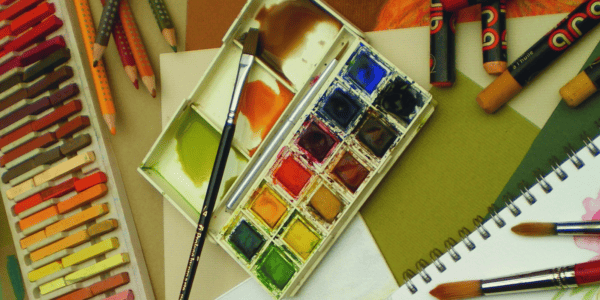This course is now fully booked. To view similar courses, visit our website here.
This course is for people of all abilities, with step-by-step demonstrations throughout as well as particular focus on colour-mixing (from a limited few) in relation to matching the colours of nature.
We will look for outside reference, ideas and inspiration within the grounds to create our own artwork working outdoors if possible, as well as developing ideas in the studio. Jeremy’s aim is to try and capture something of the mood and atmosphere of the place and the moment as simply and directly as possible.
It is recommend to work in sketchbooks/workbooks (cartridge and watercolour paper) to build up a visual diary that can then be used for further reference and experimentation.
Tutor: Jeremy Ford
Jeremy studied Graphic Design at Southport College of Art, (1972-5) and Illustration at Harrow College of Art, London (1975-8) A professional artist and Illustrator since then, working on a wide variety of books, magazines, and greeting cards. Instructional watercolour, pastel, and gouache art books published by Search Press. Work commissioned by The Royal Horticultural Society, Bradford Exchange Limited Edition Plates, and American Express Travel Guides, amongst many others. DVDs on painting in watercolour, pastel, and gouache and has contributed to numerous art books. In regular demand as a teacher and demonstrator and has a Certificate in Education (Post 16.) Demonstrates painting at many popular art events, working in all paint media. Demonstrated for St. Cuthbert's Paper Mill, (makers of Bockingford and Saunders Waterford watercolour papers) previously Senior Tutor and Principal UK Demonstrator for the Michael Wilcox School of Colour. Professional Associate and Former President of the S.A.A.
What's Included
Before You Attend
What to Bring
- Paints: I don't insist that people use the same colours as me so please bring the colours you are familiar with. If you are considering buying artists quality colours then I recommend the following tubes or pans:
Ultramarine, (sometimes called French Ultramarine)
Phthalocyanine Blue (sometimes abbreviated to Phthalo Blue. N.B. Winsor & Newton call it Winsor Blue Green Shade, or Intense Blue. Daler-Rowney call it Phthalo Blue (Green Shade)
(If people already have Prussian Blue, it is similar and will do)
Cerulean Blue, Cadmium Red Light or Cadmium Red Pale, or Vermillion. Cadmium Red, which is slightly darker will do. Permanent Rose, (Quinacridone Violet is the same, as is Quinacridone Rose) Alizarin Crimson will do but like Rose Madder and Carmine, is darker and duller.
Cadmium Yellow or Cadmium Yellow Light, or Cadmium Yellow Pale.
Hansa Yellow Light, or Winsor Yellow, or Winsor Lemon, or Lemon Yellow (but NOT Lemon Yellow Nickel Titanate) Burnt Sienna. Burnt Umber or Sepia. (Not essential but useful)
Quinacridone Gold and/or Raw Sienna and/or Yellow Ochre. Phthalocyanine Green (sometimes abbreviated to Phthalo Green. Winsor & Newton call it Winsor Green Blue Shade. Viridian or Emerald Green will do.
Permanent White gouache might be handy but isn't essential. - A B and/or 2B pencil
- An eraser
- Water containers
- Plastic water bottle
- Watercolour sketchbook, cartridge sketchbook; whatever size you like working. I work mostly on A3, A4 and slightly smaller
- Bulldog clips, elastic bands or masking tape to hold corners down
- If you prefer to work on prepared stretched paper with gumstrip and a board be prepared, otherwise stick to sketchbooks which is my preference for outdoor work
- An assortment of brushes - suggest 1, 3, 6, 8, 10 - bigger if required
- Perhaps a small rigger or linerwriter.
Please note: The course tutor will have brushes and paper for sale if necessary.
About FSC Flatford Mill
We have four buildings that are used for visitor accommodation. Whilst most rooms are either en-suite or have a dedicated bathroom, there are some rooms in The Mill that share showers and toilets at the end of the hall. If this is unsuitable for you please make the office staff aware upon booking or as soon as possible.
Please be aware that you are visiting a Field Centre that caters in the main for school parties; the accommodation is basic and dormitory style, but warm and comfortable.
Arrival Day
Check-in is between 1600-1800, if you are arriving after 1800 please advise us, so we can ensure you are advised of access codes, room key location, and room location.
You will meet the tutor at Dinner, and you will have your first session after Dinner.
Sorry this course has ended





